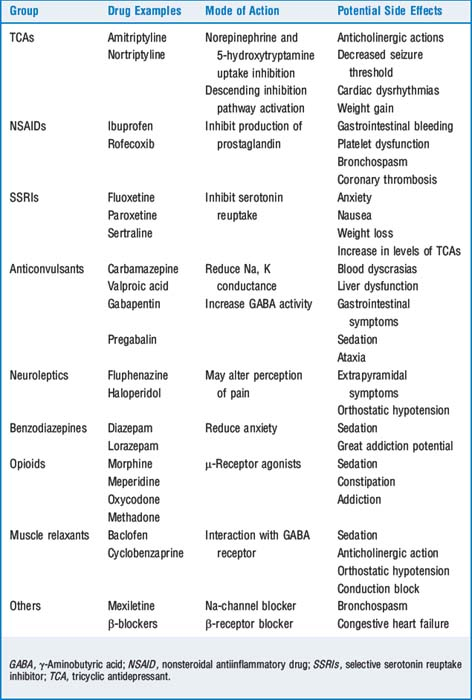CHAPTER 78 Chronic Pain Management
3 What is the classification of pain based on neurophysiologic mechanisms?
Pain can be classified according to its neurophysiologic mechanism:
 Nociceptive pain: Occurs when nociceptors are stimulated by noxious stimuli. This category is divided into somatic and visceral pain. Somatic pain sensation originates from trauma, burns, and ischemia, to name the most common ones. It is transmitted via somatic nerves. Visceral pain, as its name implies, originates from visceral structures. It is transmitted preferentially via the sympathetic fibers and is usually produced by distention, ischemia, or spasm of hollow viscera.
Nociceptive pain: Occurs when nociceptors are stimulated by noxious stimuli. This category is divided into somatic and visceral pain. Somatic pain sensation originates from trauma, burns, and ischemia, to name the most common ones. It is transmitted via somatic nerves. Visceral pain, as its name implies, originates from visceral structures. It is transmitted preferentially via the sympathetic fibers and is usually produced by distention, ischemia, or spasm of hollow viscera. Neuropathic pain: Is pain produced by an alteration in structure or function of the nervous system. Neuropathic pain can be divided into peripheral and central. Examples of peripheral neuropathic pain include CRPS II (causalgia), postherpetic neuralgia, diabetic neuropathy, and radicular pain from mechanical compression. Central neuropathic pain syndromes include poststroke pain, postparaplegic pain, and pain syndromes from multiple sclerosis.
Neuropathic pain: Is pain produced by an alteration in structure or function of the nervous system. Neuropathic pain can be divided into peripheral and central. Examples of peripheral neuropathic pain include CRPS II (causalgia), postherpetic neuralgia, diabetic neuropathy, and radicular pain from mechanical compression. Central neuropathic pain syndromes include poststroke pain, postparaplegic pain, and pain syndromes from multiple sclerosis.13 List possible etiologies of low back pain
14 What is the rationale behind the use of epidural steroids in the treatment of radicular symptoms associated with a herniated disk?
17 What are the most common medications used for intrathecal delivery via implantable delivery systems?
Key Points: Chronic Pain Management 
1. Cameron T. Safety and efficacy of spinal cord stimulation for the treatment of chronic pain: a 20-year literature review. J Neurosurg. 2004;100(3 Suppl):254-267.
2. Mease P.J., Russell I.J., Arnold L.M., et al. A randomized, double-blind, placebo-controlled, phase III trial of pregabalin in the treatment of patients with fibromyalgia. J Rheumatol. 2008;35:502-514.
3. Melzack R., Wall P. Pain Mechanism: a new theory. Science. 1965;150:971.
4. Vranken J.H., van der Vegt M.H., Kal J.E., et al. Treatment of neuropathic cancer pain with continuous intrathecal administration of S+ ketamine. Acta Anesthesiol Scand. 2004;48:249-252.











